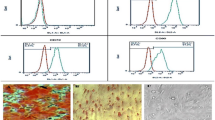Abstract
Human Parvovirus B19 (PVB19) is one of the most important pathogens that targets erythroid lineage. Many factors were mentioned for restriction to erythroid progenitor cells (EPCs). Previous studies showed that in non-permissive cells VP1 and VP2 (structural proteins) mRNAs were detected but could not translate to proteins. A bioinformatics study showed that this inhibition might be due to specific microRNAs (miRNAs) present in non-permissive cells but not in permissive EPCs. To confirm the hypothesis, we evaluated the effect of miRNAs on VP expression. CD34+ HSCs were separated from cord blood. Then, CD34+ cells were treated with differentiation medium to obtain CD36+ EPCs. To evaluate the effect of miRNAs on VP expression in MCF7 and HEK-293 cell lines (non-permissive cells) and CD36+ EPCs, dual luciferase assay was performed in presence of shRNAs against Dicer and Drosha to disrupt miRNA biogenesis. QRT-PCR was performed to check down-regulation of Dicer and Drosha after transfection. All measurements were done in triplicate. Data means were compared using one-way ANOVAs. MicroRNA prediction was done by the online microRNA prediction tools. No significant difference was shown in luciferase activity of CD36+ EPCs after co-transfection with shRNAs, while it was significant in non-permissive cells. Our study revealed that miRNAs may be involved in inhibition of VP expression in non-permissive cells, although further studies are required to demonstrate which miRNAs exactly are involved in regulation of PVB19 replication.



Similar content being viewed by others
References
Gallinella G (2013) Parvovirus B19 achievements and challenges. ISRN Virol 2013:1–33
Wong S, Zhi N, Filippone C, Keyvanfar K, Kajigaya S, Brown KE, Young NS (2008) Ex vivo-generated CD36 + erythroid progenitors are highly permissive to human parvovirus B19 replication. J Virol 82(5):2470–2476
Bonvicini F, Filippone C, Delbarba S, Manaresi E, Zerbini M, Musiani M, Gallinella G (2006) Parvovirus B19 genome as a single, two-state replicative and transcriptional unit. Virology 347:447–454
Berillo O, Khailenko V, Ivashchenko A, Perlmuter-Shoshany L, Bolshoy A (2012) miRNA and tropism of human parvovirus B19. Comput Biol Chem 40:1–6
Guan W, Cheng F, Yoto Y, Kleiboeker S, Wong S, Zhi N, Pintel DJ, Qiu J (2008) Block to the production of full-length B19 virus transcripts by internal polyadenylation is overcome by replication of the viral genome. J Virol 82(20):9951–9963
Winter K, von Kietzell K, Heilbronn R, Pozzuto T, Fechner H, Weger S (2012) Roles of E4orf6 and VA I RNA in adenovirus-mediated stimulation of human parvovirus B19 DNA replication and structural gene expression. J Virol 86(9):5099–5109
Tewary SK, Zhao H, Deng X, Qiu J, Tang L (2014) The human parvovirus B19 non-structural protein 1 N-terminal domain specifically binds to the origin of replication in the viral DNA. Virology 449:297–303
Pallier C, Greco A, Le Junter J, Saib A, Vassias I, Morinet F (1997) The 3′untranslated region of the B19 parvovirus capsid protein mRNAs inhibits its own mRNA translation in nonpermissive cells. J Virol 71(12):9482–9489
Bonvicini F, Mirasoli M, Manaresi E, Bua G, Calabria D, Roda A, Gallinella G (2013) Single-cell chemiluminescence imaging of parvovirus B19 life cycle. Virus Res 178:517–521
Huang Y, Shen XJ, Zou Q, Wang SP, Tang SM, Zhang GZ (2011) Biological functions of microRNAs: a review. J Physiol Biochem 67(1):129–139
Siomi H, Siomi MC (2010) Posttranscriptional regulation of microRNA biogenesis in animals. Mol Cell 38(3):323–332
Yeung ML, Benkirane M, Jeang K-T (2007) Small non-coding RNAs, mammalian cells, and viruses: regulatory interactions? Retrovirology 4(1):74
J-z Sun (2013) Wang J, Yuan D, Wang S, Li Z, Yi B, Mao Y, Hou Q, Liu W. Cellular microRNA miR-181b inhibits replication of mink enteritis virus by repression of non-structural protein 1 translation. PLoS One 8(12):e81515
Pillet S, Fichelson S, Morinet F (2008) Human B19 erythrovirus in vitro replication: what’s new? J Virol 82(17):8951–8953
Wolfisberg R, Ruprecht N, Kempf C, Ros C (2013) Impaired genome encapsidation restricts the in vitro propagation of human parvovirus B19. J Virol Methods 193(1):215–225
Pozzuto T, von Kietzell K, Bock T, Schmidt-Lucke C, Poller W, Zobel T, Lassner D, Zeichhardt H, Weger S, Fechner H (2011) Transactivation of human parvovirus B19 gene expression in endothelial cells by adenoviral helper functions. Virology 411(1):50–64
Chen AY, Guan W, Lou S, Liu Z, Kleiboeker S, Qiu J (2010) Role of erythropoietin receptor signaling in parvovirus B19 replication in human erythroid progenitor cells. J Virol 84:12385–12396
Luo Y, Lou S, Deng X, Liu Z, Li Y, Kleiboeker S, Qiu J (2011) Parvovirus B19 infection of human primary erythroid progenitor cells triggers ATR-Chk1 signaling, which promotes B19 virus replication. J Virol 85(16):8046–8055
Chen AY, Kleiboeker S, Qiu J (2011) Productive parvovirus B19 infection of primary human erythroid progenitor cells at hypoxia is regulated by STAT5A and MEK signaling but not HIFα. PLoS Pathog 7(6):e1002088
Filipowicz W, Bhattacharyya SN, Sonenberg N (2008) Mechanisms of post-transcriptional regulation by microRNAs: are the answers in sight? Nat Rev Genet 9(2):102–114
Zhang Y, Li Y-k (2013) MicroRNAs in the regulation of immune response against infections. J Zhejiang Univ Sci B 14(1):1–7
Huang J, Wang F, Argyris E, Chen K, Liang Z, Tian H, Huang W, Squires K, Verlinghieri G, Zhang H (2007) Cellular microRNAs contribute to HIV-1 latency in resting primary CD4 + T lymphocytes. Nat Med 13(10):1241–1247
Chiang K, Rice AP (2012) MicroRNA-mediated restriction of HIV-1 in resting CD4 + T cells and monocytes. Viruses 4(9):1390–1409
Bartel DP (2009) MicroRNAs: target recognition and regulatory functions. Cell 136(2):215–233
Acknowledgments
The present work supported by Stem Cell Technology Research Center, Tehran, Iran.
Author information
Authors and Affiliations
Corresponding author
Ethics declarations
Conflict of interest
All authors declare no conflict of interest.
Additional information
Azadeh Anbarlou and Mahshid AkhavanRahnama have contributed equally as first author to this work.
Rights and permissions
About this article
Cite this article
Anbarlou, A., AkhavanRahnama, M., Atashi, A. et al. Possible involvement of miRNAs in tropism of Parvovirus B19. Mol Biol Rep 43, 175–181 (2016). https://doi.org/10.1007/s11033-016-3952-8
Received:
Accepted:
Published:
Issue Date:
DOI: https://doi.org/10.1007/s11033-016-3952-8




